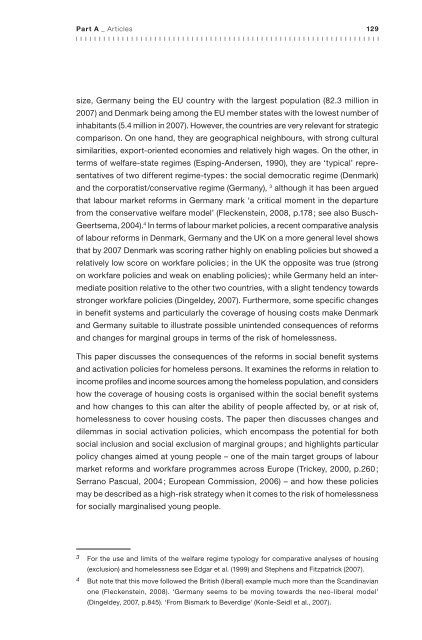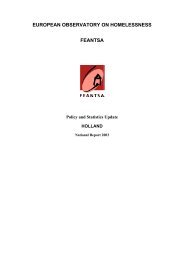Part A - Feantsa - Horus
Part A - Feantsa - Horus
Part A - Feantsa - Horus
You also want an ePaper? Increase the reach of your titles
YUMPU automatically turns print PDFs into web optimized ePapers that Google loves.
<strong>Part</strong> A _ Articles<br />
129<br />
size, Germany being the EU country with the largest population (82.3 million in<br />
2007) and Denmark being among the EU member states with the lowest number of<br />
inhabitants (5.4 million in 2007). However, the countries are very relevant for strategic<br />
comparison. On one hand, they are geographical neighbours, with strong cultural<br />
similarities, export-oriented economies and relatively high wages. On the other, in<br />
terms of welfare-state regimes (Esping-Andersen, 1990), they are ‘typical’ representatives<br />
of two different regime-types : the social democratic regime (Denmark)<br />
and the corporatist/conservative regime (Germany), 3 although it has been argued<br />
that labour market reforms in Germany mark ‘a critical moment in the departure<br />
from the conservative welfare model’ (Fleckenstein, 2008, p.178 ; see also Busch-<br />
Geertsema, 2004). 4 In terms of labour market policies, a recent comparative analysis<br />
of labour reforms in Denmark, Germany and the UK on a more general level shows<br />
that by 2007 Denmark was scoring rather highly on enabling policies but showed a<br />
relatively low score on workfare policies ; in the UK the opposite was true (strong<br />
on workfare policies and weak on enabling policies) ; while Germany held an intermediate<br />
position relative to the other two countries, with a slight tendency towards<br />
stronger workfare policies (Dingeldey, 2007). Furthermore, some specific changes<br />
in benefit systems and particularly the coverage of housing costs make Denmark<br />
and Germany suitable to illustrate possible unintended consequences of reforms<br />
and changes for marginal groups in terms of the risk of homelessness.<br />
This paper discusses the consequences of the reforms in social benefit systems<br />
and activation policies for homeless persons. It examines the reforms in relation to<br />
income profiles and income sources among the homeless population, and considers<br />
how the coverage of housing costs is organised within the social benefit systems<br />
and how changes to this can alter the ability of people affected by, or at risk of,<br />
homelessness to cover housing costs. The paper then discusses changes and<br />
dilemmas in social activation policies, which encompass the potential for both<br />
social inclusion and social exclusion of marginal groups ; and highlights particular<br />
policy changes aimed at young people – one of the main target groups of labour<br />
market reforms and workfare programmes across Europe (Trickey, 2000, p.260 ;<br />
Serrano Pascual, 2004 ; European Commission, 2006) – and how these policies<br />
may be described as a high-risk strategy when it comes to the risk of homelessness<br />
for socially marginalised young people.<br />
3 For the use and limits of the welfare regime typology for comparative analyses of housing<br />
(exclusion) and homelessness see Edgar et al. (1999) and Stephens and Fitzpatrick (2007).<br />
4 But note that this move followed the British (liberal) example much more than the Scandinavian<br />
one (Fleckenstein, 2008). ‘Germany seems to be moving towards the neo-liberal model’<br />
(Dingeldey, 2007, p.845). ‘From Bismark to Beverdige’ (Konle-Seidl et al., 2007).




